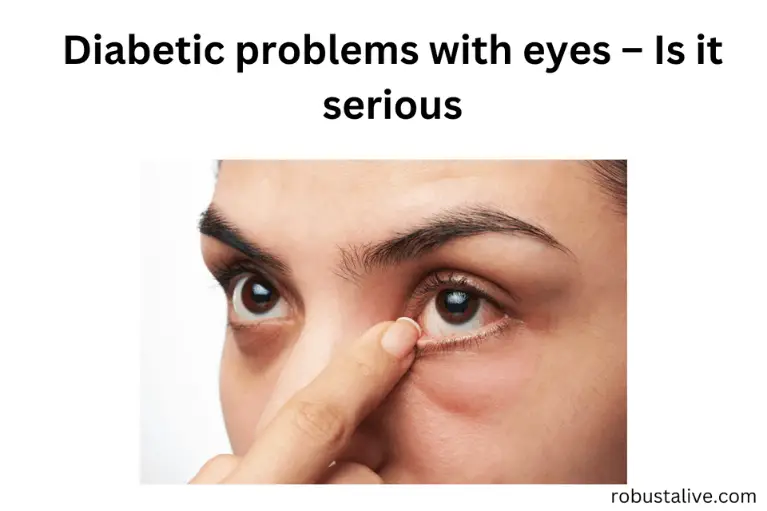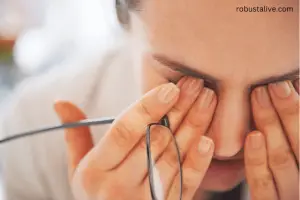Diabetic Problems With Eyes – Is It Serious?

Diabetes can damage your eyes with time, resulting in vision loss and sometimes even blindness. Fortunately, managing your diabetes at the recommended level and going for regular eye checkups can prevent the worsening of these issues.
Generally, there are four common diabetic problems with eyes: macular edema, glaucoma, diabetic retinopathy, and contracts. All of this can lead to vision loss, but early diagnosis and timely treatment can go a long way toward protecting your eyes and eyesight.
People generally asked whether diabetes can affect my eyes. Yes, it can, so you should keep up with eye checkups, especially if you have diabetes. High blood glucose levels can result in contracts, glaucoma, blurry vision, and retinopathy. Diabetes is the common cause of blindness in adults aged 20 to 70.
What is Diabetic Eye Disease?

A diabetic eye disease is a group of eye problems that can affect people with diabetes. These conditions include diabetic macular edema, cataracts, and glaucoma. With time diabetes can damage your eyes.
As time passes, diabetes can affect your vision, which can lead to poor vision and even blindness. But fortunately, you can take preventive steps to protect your eyes from further damage.
The ideal way to protect your eye from further damage includes the following:
- Manage the levels of your blood glucose, cholesterol, and blood pressure; this step is known as the diabetes ABC.
- If you are a smoker, get immediate help to quit permanently.
- Have a dilated eye exam each year.
Generally, there is no warning sign that you are going through vision loss or have diabetic eye disease. It’s difficult to notice the initial damage. A complete dilated eye exam will help your eye specialist determine if you have any eye issues in the early stages. It can even detect vision loss.
How does Ddiabetes affect my Eyes?
Diabetes affects your eyes when your blood sugar level keeps getting high.
-
Short Term
You will not likely face the vision loss issue if you have a high blood sugar level. Some people go through the blurry vision for weeks or days when changing their diabetes care medicines.
High sugar level affects the fluid levels that can cause swelling around the eye tissues (that help in focus) and result in blurred vision. It is a temporary blurry vision that gets better as soon as your blood glucose level returns to normal.
-
If your blood sugar level keeps getting high over time
If you face this issue, there are many chances it can affect the small blood vessels in the back of your eyes. This damage starts during the pre-diabetes stage when your blood sugar level increases.
The damaged blood vessels can leak fluid, which can result in swelling. At the same time, the new but weak vessels start growing. The blood vessels can bleed in the middle of our eyes, leading to scarring or even dangerously high pressure inside our eyes.
The most severe diabetic issues of the eyes start with blood vessel issues.
Symptoms of Diabetic problems with Eyes
Generally, there are no symptoms of diabetic eye disease. You may feel no change or pain in the vision when the damage initiates inside your eye. It mostly happens in the case of diabetic retinopathy.
The common symptoms include:
- Poor color vision
- Flashes and light
- Blurry and wavy vision
- Vision loss and dark areas
- Flashes of light
- Dark strings and spots
- Frequently changing vision
Talk with your eye doctor if you are experiencing any of the above symptoms.
Common Diabetic Eye Diseases
Here are the four common diabetic problems with eyes:
-
Diabetic Retinopathy
The inner lining at the back of our eye is called the retina. The retina senses the light and turns them into signals that our brain can decode, leading us to see the world. Once the blood vessels get damaged, they can harm the retina and cause the disease known as diabetic retinopathy.
In early diabetic retinopathy, the blood vessels start leaking, weakening, and bulging into the retina. This stage is known as non-proliferative diabetic retinopathy. When the condition gets worse, the blood vessels get closed, and results in the formation of new vessels. This stage is known as proliferative diabetic retinopathy, besides the abnormal new vessels, and results in serious eye issues.
-
Cataracts
Our eye lenses are the sharp structures that benefit us with clear vision, but unfortunately, they start getting cloudy as we age. In diabetic people, the chances of cloudy lenses are more significant, and they can begin even before age. This condition is known as cataracts.
In comparison to healthy people, diabetic people can develop cataracts at an early age. According to an eye specialist, high glucose levels result in the building of deposits on the lenses in our eyes.
-
Macular Edema
The macula is the vital part of our retina that helps us drive, read, and see faces. Diabetes causes swelling in our macula, known as diabetic macular edema. With time, it destroys the sharp vision of that part, resulting in partial blindness or vision.
It usually develops in people who already have diabetic retinopathy signs.
-
Glaucoma
Glaucoma eye disease can damage the optic nerve that connects our brain and eyes. A diabetic person is two times at risk of getting this disease, which can lead to blindness and vision loss if the treatment is delayed.
The symptoms vary with the type of glaucoma.
Diabetic Retinopathy
Diabetic retinopathy is the most common diabetic problem with the eyes. The damage to our light-sensitive tissues and blood vessels is the cause of this disease. This condition can be in anyone with type 1 or type 2 diabetes.
The diabetic retinopathy risks increase with time in diabetic people or if they have irregular blood glucose levels.
Symptoms
In the early stages, you may not experience any symptoms. But as the condition progresses, you will start noticing the following signs.
- Blurred vision
- Fluctuating vision
- Vision loss
- Spots and dark strings that float in your vision
- Empty or dark areas
Causes
With time high blood sugar levels result in the blockage of the tiny blood vessels that can nourish our retina and cut off the blood supply. As a result, our eye starts growing new vessels that will not develop properly and starts leaking.
Type of Diabetic Retinopathy
There are two types of diabetic retinopathy:
-
Early Diabetic Retinopathy:
The standard form known as diabetic retinopathy (NDPR) is a type in which the new blood vessels aren’t growing. When you have this condition, the blood vessel walls weaken and leak the fluid and blood back into your retina. The large retinal vessels begin the dilation and get an irregular diameter.
The condition can progress from mild to severe, and the vessels get entirely blocked. Sometimes this condition results in the building of fluids in the retina’s center portion called the macula. The macular edema requires immediate attention and treatment to prevent permanent vision loss.
-
Advanced Diabetic Retinopathy:
Diabetic retinopathy can progress to the more severe type called proliferative diabetic retinopathy. The damaged blood vessels can get close and result in the growth of abnormal blood vessels in the retina. These blood vessels are fragile, resulting in the jelly-like substance’s leakage. This jelly-like material fills the center of the affected eye.
Besides, the scar tissues from the new blood vessel growth can cause retina detachment from the back of the eye. The pressure can build up in the eye if the new blood vessels interfere with the flow. This fluid damages the nerves that carry the images from the eyes to the brain and results in glaucoma.
Risk Factors
Any diabetic patient can develop diabetic retinopathy. In the case of the following factors, the chances get doubled:
- High blood pressure
- Pregnancy
- Having diabetes for an extended period
- High cholesterol
- Poor blood glucose control
- Tobacco
Prevention
You can’t always prevent diabetic problems with eyes. However, proper eye checkups, reasonable control of blood pressure and blood sugar, and early intervention can benefit the prevention of severe vision problems.
You can follow the following methods to reduce the chances of getting diabetic retinopathy as much as possible.
-
Manage Your Diabetes
Make physical activity and healthy eating a part of your daily life. Try getting at least 150 minutes of moderate aerobic exercise, like taking a daily walk. Take insulin or oral diabetes medications as prescribed by your doctor.
-
Quit smoking and ask for help from a specialist
If you are a regular smoker, quit smoking, and if it’s difficult for you, ask the doctor for help. Smoking can increase the risk of various diabetes complications like diabetic retinopathy.
-
Monitor your blood glucose level
If you have an irregular blood sugar level, try keeping track, and checking multiple times, especially if you are under stress. Consult a doctor when and how many times you need to check your sugar levels.
-
Keep your blood cholesterol and blood pressure in control
Regular exercise and healthy eating can benefit in losing extra weight and maintaining cholesterol and blood pressure. Sometimes your doctor can prescribe you medications accordingly.
-
Ask your doctor about a glycosylated hemoglobin test
The hemoglobin A1C and glycosylated hemoglobin test reflect your average blood glucose level for the last two or three months. For the maximum number of diabetes patients, the A1C goal is under 7%.
-
Notice if you have the vision changes.
Contact your eye doctor if you have any vision changes or if your eyesight is becoming spotty or blurry.
Who has more chances of getting diabetic eye disease?
Any diabetic person can develop diabetic eye disease. You will have a higher risk in the case of:
- High blood pressure that is mostly at elevated levels
- Uncontrolled blood sugar level
Smoking and high blood cholesterol also increase the risk of diabetic eye disease. According to the studies, some groups are at high risk of developing diabetic eye diseases. Alaska natives, Pacific Islanders, Hispanics, American Indians, African Americans, and older adults are at risk of getting blind and losing vision.
Besides, if you have diabetes and get pregnant, you have a greater chance of developing eye issues. If you have already gone through diabetic retinopathy, there are chances that it can get worse. Diabetes that occurs during pregnancy is called gestational diabetes; generally, it’s temporary and doesn’t harm the eyes or vision. But, still, more research is needed.
The rate of diabetic problems with eyes percentage increases with the time you have had diabetes.
How do doctors diagnose diabetic eye issues?
A dilated eye exam is the best way to check if you have any eye issues because of your diabetes. Firstly to widen your pupils, your doctor will put drops in your eyes. The widened pupil benefits in examining a larger area at the back of your eye. It’s done using a magnifying glass. After the dilated eye exam, your vision will be slightly blurred.
Your eye specialist will also:
- Measure the pressure in the eyes
- Test your vision
Your doctor can also suggest other tests depending on your health history. Diabetic people should see an eye care specialist yearly for a dilated eye exam. Your healthcare team can also offer a different treatment plan based on the diabetic condition and the time you have it first diagnosed.
Conclusion
Maintain your blood glucose levels to prevent eye damage from your diabetes. Strictly follow your primary care physician’s diet and exercise plan. If you have never had an eye exam with an ophthalmologist, don’t delay it. And make sure to attend the follow-up exams as recommended by your ophthalmologist.
FAQ’s
-
How can I tell if my diabetes is affecting my eyes?
When your diabetes starts disturbing your eyes, you will notice the following symptoms.
- Poor color vision
- Flashes of light
- Wavy or blurry vision
- Dark strings or spots
- Vision loss and dark areas of skin
-
How long does it take for diabetes to affect the eyes?
It generally takes 5 to 10 years to notice diabetic eye problems. However, that not means you can’t develop any before then. Uncontrolled blood sugar can result in eye damage long before the time, and you may not notice any symptoms. Diabetic problems with eyes can result in severe eyesight loss and even blindness.
-
What does diabetic eye damage?
The retina blood vessels start leaking the gel-like fluid into the eye. It makes you see the floating spots, dark streaks like cobwebs. Sometimes these spots get away on their own, but still, it’s vital to get the treatment.
-
Can diabetic eyes heal?
Though the treatment stops or slows down the progression of diabetic retinopathy, it’s not a permanent cure. Because diabetes is a lifelong condition, it is still possible that you will get diabetic retinopathy in the future. Even after the diabetic retinopathy treatment, you need to keep up with regular checkups to avoid any complications in the future.
-
What percentage of diabetic people get blind?
Though many people have diabetic problems with eyes, only 5% suffer from severe vision loss; for a diabetic person, the risk of developing retinopathy is related to the time he had diabetes. Both type 1 and 2 diabetics can have retinal damage that results in blindness.
References:
- https://www.cdc.gov/diabetes/managing/diabetes-vision-loss.html#:~:text=Eye%20diseases%20that%20can%20affect,way%20toward%20protecting%20your%20eyesight.
- https://www.niddk.nih.gov/health-information/diabetes/overview/preventing-problems/diabetic-eye-disease
- https://www.aao.org/eye-health/diseases/diabetic-eye-disease
- https://www.mayoclinic.org/diseases-conditions/diabetic-retinopathy/symptoms-causes/syc-20371611
- https://www.aao.org/eye-health/diseases/what-is-diabetic-retinopathy
- https://www.webmd.com/diabetes/diabetes-eye-problems





